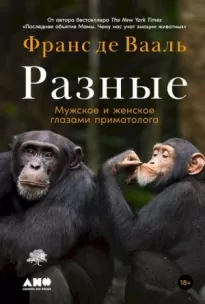Разные. Мужское и женское глазами приматолога

- Автор: Франс де Вааль
- Жанр: Научно-популярная литература
- Дата выхода: 2023
Читать книгу "Разные. Мужское и женское глазами приматолога"
Todd, B. K., et al. 2018. Sex differences in children's toy preferences: A systematic review, meta-regression, and meta-analysis
Tokuyama, N., and T. Furuichi. 2017. Do friends help each other? Patterns of female coalition formation in wild bonobos at Wamba.
Tokuyama, N., T. Sakamaki, and T. Furuichi. 2019. Inter-group aggressive interaction patterns indicate male mate defense and female cooperation across bonobo groups at Wamba, Democratic Republic of the Congo.
Townsend, S. W., T. Deschner, and K. Zuberbühler. 2008. Female chimpanzees use copulation calls flexibly to prevent social competition.
Tratz, E. P., and H. Heck. 1954. Der afrikanische Anthropoide «Bonobo,» eine neue Menschenaffengattung.
Travis, C. B. 2003.
Trivers, R. L. 1972. Parental investment and sexual selection. In
Troje, N. F. 2002. Decomposing biological motion: A framework for analysis and synthesis of human gait patterns.
Trost, S. G., et al. 2002. Age and gender differences in objectively measured physical activity in youth.
Turner, P. J., and J. Gervai. 1995. A multidimensional study of gender typing in preschool children and their parents: Personality, attitudes, preferences, behavior, and cultural differences.
Tutin, C. E. G. 1979. Mating patterns and reproductive strategies in a community of wild chimpanzees.
Utami Atmoko, S. S. 2000.
Vacharkulksemsuk, T., et al. 2016. Dominant, open nonverbal displays are attractive at zero-acquaintance.
Vaden-Kierman, N., et al. 1995. Household family structure and children's aggressive behavior: A longitudinal study of urban elementary school children.
van Hooff, J. A. R. A. M. 2019.
van Leeuwen, E., K. A. Cronin, and D. Haun. 2014. A group-specific arbitrary tradition in chimpanzees (Pan troglodytes).
van Schaik, C. 2004.
van Woerkom, W., and M. E. Kret. 2015. Getting to the bottom of processing behinds.
Vasey, P. L. 1995. Homosexual behavior in primates: A review of evidence and theory.
Vauclair, J., and K. Bard. 1983. Development of manipulations with objects in ape and human infants.
Verloigne, M., et al. 2012. Levels of physical activity and sedentary time among 10-to 12-year-old boys and girls across 5 European countries using accelerometers: An observational study within the ENERGY-project.
Vines, G. 1999. Queer creatures.
Volk, A. A. 2009. Human breastfeeding is not automatic: Why that's so and what it means for human evolution.
von Rohr, C. R., et al. 2012. Impartial third-party interventions in captive chimpanzees: A reflection of community concern.
Voskuhl, R., and S. Klein. 2019. Sex is a biological variable — in the brain too.
Watts, D. P., F. Colmenares, and K. Arnold. 2000. Redirection, consolation, and male policing. In
Watts, D. P., et al. 2006. Lethal intergroup aggression by chimpanzees in Kibale National Park, Uganda.
Wayne, S. 2021.
Weatherford, J. 2004. Genghis Khan and the Making of the Modern World. New York: Broadway Books. Уэзерфорд Дж. Чингисхан и рождение современного мира / Пер. с англ. Е. Лихтенштейна. — М.: АСТ; Владимир: ВКТ, 2008. С. 223.
Weidman, N. 2019. Cultural relativism and biological determinism: A problem in historical explanation.
Weisbard, C., and R. W. Goy. 1976. Effect of parturition and group composition on competitive drinking order in stumptail macaques.
Westneat, D. F., and R. K. Stewart. 2003. Extra-pair paternity in birds: Causes, correlates, and conflict.
Westover, T. 2018.
White, E. 2002.
Wickler, W. 1969. Socio-sexual signals and their intra-specific imitation among primates. In
Wiederman, M. W. 1997. The truth must be in here somewhere: Examining the gender discrepancy in self-reported lifetime number of sex partners.
Williams, C. L., and K. E. Pleil. 2008. Toy story: Why do monkey and human males prefer trucks?
Wilson, E. A. 1998.
—. 2000. Neurological preference: LeVay's study of sexual orientation.
Wilson, E. O. 1978.
Wilson, M. L., et al. 2014. Lethal aggression in Pan is better explained by adaptive strategies than human impacts.
Wiseman, R. 2016.
Wittig, R. M., and C. Boesch. 2005. How to repair relationships: Reconciliation in wild chimpanzees.
Wolfe, L. 1979. Behavioral patterns of estrous females of the Arashiyama West troop of Japanese macaques.
Wrangham, R. W. 2019.
Wrangham, R. W., and D. Peterson. 1996.
Yamamichi, M., J. Gojobori, and H. Innan. 2012. An autosomal analysis gives no genetic evidence for complex speciation of humans and chimpanzees.
Yamamoto, S., T. Humle, and M. Tanaka. 2009. Chimpanzees help each other upon request.
Yancey, G., and M. O. Emerson. 2016. Does height matter? An examination of height preferences in romantic coupling.
Yerkes, R. M. 1925.
—. 1941. Conjugal contrasts among chimpanzees.
Yong, E. 2019. Bonobo mothers are very concerned about their sons' sex lives.
Young, L., and B. Alexander. 2012.
Zahn-Waxler, C., et al. 1992. Development of concern for others.
Zhou, J.-N., M. Hofman, L. Gooren, and D. F. Swaab. 1995. A sex difference in the human brain and its relation to transsexuality.
Zhou, W., et al. 2014. Chemosensory communication of gender through two human steroids in a sexually dimorphic manner.
Zihlman, A. L., et al. 1978. Pygmy chimpanzee as a possible prototype for the common ancestor of humans, chimpanzees, and gorillas.
Zimmer, C. 2018.
Zuckerman, S. 1932.
—. 1991. Apes are not us.





